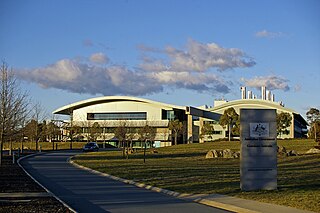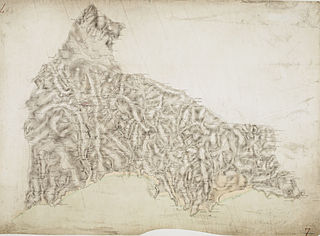Related Research Articles

Remote sensing is the acquisition of information about an object or phenomenon without making physical contact with the object, in contrast to in situ or on-site observation. The term is applied especially to acquiring information about Earth and other planets. Remote sensing is used in numerous fields, including geophysics, geography, land surveying and most Earth science disciplines ; it also has military, intelligence, commercial, economic, planning, and humanitarian applications, among others.

The Landsat program is the longest-running enterprise for acquisition of satellite imagery of Earth. It is a joint NASA / USGS program. On 23 July 1972, the Earth Resources Technology Satellite was launched. This was eventually renamed to Landsat 1 in 1975. The most recent, Landsat 9, was launched on 27 September 2021.

Geoinformatics is a technical science primarily within the domain of Computer Science. It focuses on the programming of applications, spatial data structures, and the analysis of objects and space-time phenomena related to the surface and underneath of Earth and other celestial bodies. The field develops software and web services to model and analyse spatial data, serving the needs of geosciences and related scientific and engineering disciplines. The term is often used interchangeably with Geomatics, although the two have distinct focuses; Geomatics emphasizes acquiring spatial knowledge and leveraging information systems, not their development.
A geological survey is the systematic investigation of the geology beneath a given piece of ground for the purpose of creating a geological map or model. Geological surveying employs techniques from the traditional walk-over survey, studying outcrops and landforms, to intrusive methods, such as hand augering and machine-driven boreholes, to the use of geophysical techniques and remote sensing methods, such as aerial photography and satellite imagery. Such surveys may be undertaken by state, province, or national geological survey organizations to maintain the geological inventory and advance the knowledge of geosciences for the benefit of the nation. A geological survey map typically superimposes the surveyed extent and boundaries of geological units on a topographic map, together with information at points and lines. The maps and reports created by geological survey organisations generally aim for geographic continuity and completeness in establishing the spatial patterns of near-surface rock units. The map may include cross sections to illustrate the three-dimensional interpretation. Subsurface geological and geophysical maps, providing limited coverage of deeper geology, are maintained internally by major oil companies and regulators. Some geological survey organisations have collaborated with them to include subsurface geology in their systematic surveys, for example, the Geological Atlas of the Western Canada Sedimentary Basin. Subsurface maps typically depict the three-dimensional form of geological surfaces by means of contours and cross sections. Computer-based models are increasingly used to provide more comprehensive information storage and greater flexibility of presentation. In the United States, the 50 state surveys are coordinated by the Association of American State Geologists.

Geoscience Australia is an agency of the Australian Government. It carries out geoscientific research. The agency is the government's technical adviser on all aspects of geoscience, and custodian of the geographic and geological data and knowledge of the nation.

The Murchison is a loosely defined area of Western Australia located within the interior of the Mid West region. It was the subject of a major gold rush in the 1890s and remains a significant mining district. The Murchison is also included as an interim Australian bioregion. The bioregion is loosely related to the catchment area of the Murchison River and has an area of 281,205 square kilometres (108,574 sq mi).
The Indian Institute of Remote Sensing is an institute for research, higher education and training in the field of remote sensing, geoinformatics and GPS technology for natural resources, environmental and disaster management under the Indian Department of Space, which was established in the year 1966. It is located in the city of Dehradun, Uttarakhand.

Land cover is the physical material at the surface of Earth. Land covers include grass, asphalt, trees, bare ground, water, etc. Earth cover is the expression used by ecologist Frederick Edward Clements that has its closest modern equivalent being vegetation. The expression continues to be used by the United States Bureau of Land Management.

Fugro is a Dutch multinational public company headquartered in Leidschendam, Netherlands. The company is primarily a service company focused on geotechnical, survey and geoscience services, and is listed on Euronext Amsterdam. Mark Heine is Fugro's CEO and Chairman of the Board of Management, while Harrie L.J. Noy is Chairman of the Supervisory Board.
The Department of Resources, Energy and Tourism was an Australian Government department. It was formed in December 2007 and dissolved on 18 September 2013. The majority of its functions were assumed by the Department of Industry; with the exception of tourism functions that were assumed by the Department of Foreign Affairs and Trade.

Landsat 8 is an American Earth observation satellite launched on 11 February 2013. It is the eighth satellite in the Landsat program; the seventh to reach orbit successfully. Originally called the Landsat Data Continuity Mission (LDCM), it is a collaboration between NASA and the United States Geological Survey (USGS). NASA Goddard Space Flight Center in Greenbelt, Maryland, provided development, mission systems engineering, and acquisition of the launch vehicle while the USGS provided for development of the ground systems and will conduct on-going mission operations. It comprises the camera of the Operational Land Imager (OLI) and the Thermal Infrared Sensor (TIRS), which can be used to study Earth surface temperature and is used to study global warming.

The Operational Land Imager (OLI) is a remote sensing instrument aboard Landsat 8, built by Ball Aerospace & Technologies. Landsat 8 is the successor to Landsat 7 and was launched on February 11, 2013.

A national mapping agency is an organisation, usually publicly owned, that produces topographic maps and geographic information of a country. Some national mapping agencies also deal with cadastral matters.
NPA Satellite Mapping is the longest-established satellite mapping specialist in Europe, with expertise in geoscience applications of earth observation and remote sensing. In addition to processing and distributing data from a variety of optical and radar satellites, NPA specialises in added-value and derived products, providing validation and interpretation of satellite-based imagery.

Barry N. Haack is an American geographer and Emeritus Professor in the Department of Geography and Geoinformation Science at George Mason University in Fairfax, Virginia. He is an international authority on remote sensing, geographic information systems (GIS), and technology transfer from developed to developing nations. Haack is a visiting physical scientist at the United States Geological Survey and an elected Fellow in the American Society for Photogrammetry and Remote Sensing (ASPRS). Through education and collaboration, Haack has influenced the careers of scientists and decision makers from many United States federal agencies and in universities and agencies in nearly thirty countries. He has held formal arrangements with the United Nations, World Bank, Inter-American Development Bank, NASA, the European Space Agency, the National Geographic Society, and many other international organizations and country governmental agencies.
The Department of National Development was an Australian government department that existed between March 1950 and December 1972, and briefly between December 1977 and December 1979.
The Canada Centre for Mapping and Earth Observation (CCMEO) (formerly Canada Centre for Remote Sensing (CCRS)) is a branch of Natural Resources Canada's Earth Science Sector. It was created in 1970 with Lawrence Morley as the first Director General. The department also works closely with the private sector, especially with the development of GIS software.
Dr. Y. S. Rao is a professor at the Centre of Studies in Resources Engineering, Indian Institute of Technology Bombay, Mumbai, India. He is working in the field of microwave remote sensing and land based applications for more than 34 years. His early research was focused on the use of Synthetic Aperture Radar (SAR) interferometry for landslides and land deformation monitoring, Digital Elevation Model generation, snow and glacier monitoring. He is also actively involved in developing several techniques for soil moisture estimation using passive and active microwave remote sensing data for more than 25 years. His current research involves SAR Polarimetry for crop characterization, classification, biophysical parameter retrieval using linear and compact-pol SAR data. Apart from applications, he has also contributed in the field of Polarimetric SAR system calibration and software tool development.
Avik Bhattacharya is a professor at the Centre of Studies in Resources Engineering, Indian Institute of Technology Bombay, Mumbai, India. He has been working in the field of radar polarimetry theory and applications for more than a decade. His main focuses on the use of synthetic aperture radar (SAR) data for land use classification, change detection and qualitative and quantitative biophysical and geophysical information estimation.
Land cover maps are tools that provide vital information about the Earth's land use and cover patterns. They aid policy development, urban planning, and forest and agricultural monitoring.
References
- ↑ "$ 15.8m for building". The Canberra Times . 4 July 1991. p. 2. Retrieved 20 December 2015– via National Library of Australia.
- ↑ Australian Surveying and Land Information Group (1991), AUSLIG : Australian Surveying & Land Information Group, Australian Surveying and Land Information Group, retrieved 20 December 2015
- ↑ Australian Surveying and Land Information Group (1997), Australia's maritime zones (Ed. 1 ed.), AUSLIG, retrieved 20 December 2015
- ↑ Australian Surveying and Land Information Group; Space-Time Research (Firm) (1996), Australia unfolded interactive atlas of Australia, AUSLIG, retrieved 20 December 2015
- ↑ Australian Survey Office (1984), The Australian Survey Office, Commonwealth Department of Administrative Services, The Office, retrieved 20 December 2015
- 1 2 "Our History". Geoscience Australia. Archived from the original on 27 February 2002. Retrieved 26 March 2021.
- ↑ "Mapping chief retires". The Canberra Times . 3 July 1965. p. 10. Retrieved 20 December 2015– via National Library of Australia.
- ↑ Australia. Division of National Mapping; Plumb, T. W. (Trevor W.) (1962), Atlas of Australian resources (2nd series ed.), Division of National Mapping, retrieved 20 December 2015
- ↑ Australia. Division of National Mapping (1987), Australia fuels, The Division, retrieved 20 December 2015
- ↑ Australia. Division of National Mapping (1986), Climate, The Division, ISBN 978-0-642-51506-3
- ↑ Australia. Division of National Mapping (1982), Atlas of Australian resources third series. Volume 3, Agriculture (Third series ed.), Division of National Mapping, ISBN 978-0-642-51482-0
- ↑ Australian Landsat Station; Australia. Dept. of Science and Technology (1982), Australian Landsat Station, Australian Government Publishing Service, retrieved 20 December 2015
- ↑ Australian Centre for Remote Sensing (1990), ACRES, Australian Centre for Remote Sensing, retrieved 21 December 2015
- ↑ Australian Centre for Remote Sensing (1990), ACRES user manual (2nd ed.), Australian Centre for Remote Sensing (published 1991), ISBN 978-0-642-15505-4
- ↑ Australian Surveying and Land Information Group; Australian Geological Survey Organisation (1999), Discovering remote sensing, Australian Geological Survey Organisation, ISBN 978-0-642-39790-4
- ↑ Australian Centre for Remote Sensing (1991), ACRES update, Australian Centre for Remote Sensing, retrieved 21 December 2015
- ↑ Golding, Peter; Holland, Peter (March 1988), "Remote sensing in the Australian Survey Office", Surveying Australia, 10 (1): 15+, retrieved 21 December 2015